
StabMe
-
Posts
46 -
Joined
-
Last visited
Content Type
Forums
Events
Gallery
Posts posted by StabMe
-
-
Ok, here is how it currently looks:
I was afraid that putting absorption will decrease the subjective width of the soundstage and decrease the liveliness. But the soundstage now feels even more wider, highs are even more pronounced which will have to be dealt with the housecurve (speakers are EQed flat 1m on axis currently) and the amount of detail that has emerged after those treatments is kind of spooky - can't think of any other word. I moved the speakers into the room away from corners about 30cm in AND installed traps across the corner - maybe this is the reason low end is kind of lacking.
I do not have a lot of experience listening to high quality setups. This is probably the closest I have ever approached to a "quality setup", but I haven't heard a system that is so crisp, detailed, so loud and images as great as this.
Will get back with the measurements later today.
-
 6
6
-
-
This weekend I will be installing absorbers - 10 huge 2x0,6 meters and 4 smaller 1x0,6 meters. Thickness of the material is 10cm and there is an additional air gap of 5cm. I will be also placing 6 Leanfusers on the back wall and one leanfuser on each side near the listening position.
Here is how the whole setup will look like:
Ceiling diffuser is not shown.
Listening position is 4.7 meters from the front wall. Horn mouth is about 1 meter from the corner now, because i am going to place bass trap across the corner to tame some resonances. Angled sides of the speaker are now about 20cm from the walls because of that too (they were right at the walls before.
Looking at the picture and on those traps, I have a few worries:
- I moved the speaker a bit away from corners - will it reduce the loading significantly?
- absorbers are 15cm deep (6") - can it negatively affect the sound by creating surfaces for unwanted reflections?
- As can be seen on the front wall, it is almost fully treated, but is there enough treatment near the edges of the horn that is closer to the side walls?
- Does it look like I am overtreating the room? I would only be glad to keep everything as it was, but i still have 1000-1200ms reverberation so this seems like the only way to tame it.
Thanks!
-
 3
3
-
-
9 minutes ago, DirtyErnie said:
That's a little 'less bad'. Easiest approach might be building some sort of divider at a ratio-friendly distance. I've also heard of placing heavy absorption/diffusion behind that distance; leave the listening part of the room lively, and heavily killing anything that goes past the 'golden ratio' point.
This is a big project, I applaud your efforts!Yeah, a bit less bad
 Unfortunately, I am locked into these dimensions. At the end of the room we have a big window and there is a door just in the beginning of the room. So, dividing the space is out of question.
Unfortunately, I am locked into these dimensions. At the end of the room we have a big window and there is a door just in the beginning of the room. So, dividing the space is out of question.
Maybe when I move to another house...
-
 1
1
-
-
11 minutes ago, NBPK402 said:
Better than square...best would be not divisible by the same number though. Not sure what you can do about that though. My room is worse...we have to each deal with what we have as a room unless we custom build it. I am sure you will get it tuned to be the best that it can be.
Actually, i already can hear HUGE improvement. Speech in movies is much easier to comprehend. Imaging is much better and i can hear a lot more detail.
Currently I have those diffusers on the ceiling and Leanfusers on the backwal simply standing on the floor. Can't wait to have my absorbers installed - this will improve the sound even further.
I am afraid that I won't be able to tame resonance on very low frequencies - below 100Hz. Maybe some active absorption on the back wall with subwoofers a-la double bass array...
-
 1
1
-
-
15 hours ago, DirtyErnie said:
Square room? That's going to be rough.
Best luck I had there was with taking down the corner tiles in a suspended ceiling. I guess the space above the ceiling acted as a 'resonator' to bleed off the nodes below the ceiling. The difference was NOT subtle.No, it is ~40X20 Ft.
-
 1
1
-
-
8 hours ago, parlophone1 said:
What are the speaker stands made of?
I seems like they might vibrate.
It is painted rectangular steel tube. I should have filled them with sand, actually. But since the weight of the speakers is really huge (I expect about 60-70 kilos each), that should damp vibration.
20 hours ago, Khornukopia said:The painted surfaces should be effective for the diffusers to function the way you want. Nice work.
Thanks! Already hear huge difference in how much easier it is to listen and comprehend dialogues in movies.
-
 1
1
-
-
13 hours ago, Khornukopia said:
Looks good. What is the material used to construct the diffuser blocks?
I used XPS at 35 kg/m3 density. Diffuser geometry was calculated in QRDude. I bought XPS insulation and used a local workshop with CNC hot wire. Then diffusers were painted. I used foam glue when attaching those to the ceiling.
Hope that the material is dense enough to reflect sound at frequencies it is supposed to work. And i am not terribly against some absorption if it happens as well, especially at lower frequencies.
-
 1
1
-
-
On 10/31/2021 at 6:12 PM, Seadoc said:
Very Nice !! I too wanted to build my own horns. And did with the help of forum members, who offered point data, on dimensions for the K-400 horns.
Hey! Did you document build process here on the forum? Wasn't able to find a thread.
-
First step in room treatment complete - installed ceiling duffusers.
It is an area of 3 by 3 meters. Half of it (13 pieces) is filled with 2D diffusers (600Hz-2200Hz diffusion) and the rest (12 pieces) are 1D diffusers which should work between 2200-6800Hz.
Hope, that mixing 1D and 2D diffusion is not a big deal.
The reason i decided to go this way is cost savings. Building 2D diffusors with 23 wells to necessary to cover the whole bandwidth would cost a lot more for me than to build half as much 7 well 2D diffusers and the rest 1D diffusers.
Next up are bas traps and back wall diffusers. Oh and a carpet.
-
 2
2
-
-
Ron, did you have a chance to measure your RT60?
-
When I am listening at high levels, I usually feel the floor vibrating.
Looking at the waterfall graphs, I see very long decay times on some frequencies.
So I figured what if it is the floor that is ringing having its own resonances?
Here is an overlay of full range signal (before correction) and an RTA signal of me hitting the floor with my heel. Purple is full range sweep, red is floor:

Waterfall of the full signal:

With a bit more smoothing:
Full signal was measured at 1m distance from the speaker while floor hits were produced at LP.
May I conclude that those long decays are produced by floor (18cm concrete) and there is nothing I can do about it?
OTOH, could it still be modes that get activated by me beating the floor?

I looked closely on the waterfall graphs and room simulation and find that a lot of peaks correlate.
-
 1
1
-
-
12 hours ago, Chris A said:
I haven't looked at the absorption coefficients vs. frequency of the 703 vs. 705 in many years. In general, you're looking for relatively equal absorption vs. frequency (flat absorption plot lines). If your room's RT values look like the 705 would be a better fit (i.e., the absorption values of 705 increase at frequencies where the RT values also increase), then the 705 material might be a better choice. Also, be mindful its lower frequency absorption coefficients, too, in the midbass and lower treble range.
Agree on matching absorption coefficients vs. frequency of material with RT values.
I was thinking about using OC705 (which is of double density) for the corner straddled traps and whether increasing the density of the material may somehow improve performance in the bass-midbass region. Don't get the mechanism of this kind of trap completely, so still have questions

I have some confusion WRT placing a trap behind the corner horn. From what i understand, corners are used as extensions for the horns. But when we place a trap behind, don't we negate the purpose? I know this is probably a silly question, just want to understand what's happening more clearly.
-
 1
1
-
-
33 minutes ago, Chris A said:
I use double Owens-Corning 703 fiberglass panels (total 4" thick each) in ATS Acoustic bags. They are placed across the room corners and are closed on one end (sitting on top of the TH-SPUD DIY subwoofers in each front corner).
Any potential benefit in obtaining higher density material like OC 705 (6 pcf, 96km/m3)?
34 minutes ago, Chris A said:It's important that one end is closed off in order to make it a 1/4 wavelength trap (down to ~70 Hz based on the panel length). If you leave both ends open, then it becomes a half wavelength trap (i.e., 140 Hz).
Would this picture be a good visualization of correct placement?
 21 minutes ago, Chris A said:
21 minutes ago, Chris A said:If you place the horn mouths within 2 feet (0.6 m) of a side wall, I then recommend a line of 1" (2.5 cm) thick laundry-lint-type (Roxul, etc.) squares of 2 feet by 2 feet dimensions (0.6 x 0.6 m) place just adjacent to the horn mouth exits. This will dramatically help to recapture the phantom center stereo image, in my experience.
Currently have a panel 2x4 panel with 2" fiberglass standing near each of the side edge of the horn. It does indeed improve phantom center.
I've read Corner Horn FAQ over at DIYAudio and I can see that you advice in favor of using absorption and against diffusion at least near on the front wall and side walls near the horn edges. Would you advise against using diffusors in the rest of the room if the goal is to deal with large reverberation time? I will probably be placing diffusors on the ceiling and back wall and was also going to place them on the side walls at listening position. But now I am thinking if it is better to use absorption at the sides of listening position.
I can place 3 2x4 panels at this location:

Room size is It is 10m x 6m. Or 32.8 by 19.6 feet. Currently have a TV with desk, horns, sofa and that's about it.
-
 1
1
-
-
On 10/1/2021 at 10:20 PM, Chris A said:
I'd say you've got a lot of work to do on controlling your reverberation times (RTs) unless you have an extremely large listening room. I'd aim for at least reducing the RT30 values to below 1 ms, with 0.4-0.5 ms being much more workable.
I am sure you meant 1 s, but yes - i have a lot of work to do. Will report back when i apply some treatments and measure the result. But the RT is too big at this moment.
On 10/1/2021 at 10:20 PM, Chris A said:It looks like the gain of the bass bin is set too low, and you're trying to boost the 100 Hz notch in response. I'd instead recommend boosting the overall bass bin channel, then attenuate the 200-500 Hz band, then boost the 70-130 Hz portion using no more than 3-4 dB. That way, you'll be avoiding using too much PEQ gain, which can cause internal issues with a DSP crossover.
That was a very good advice, actually.
A raised bass bin volume so that its levels matched the level of compression driver at x-over frequency. After that i attenuated the 200-500 band so that its level also matches CD at x-over. It required -17db cut at about 300Hz with Q equal to 1.
Took measurement at 1M distance:
Then ran APL correction to about 180hz and upwards to achieve this on both channels:
This is at 1/6 oct smoothing so one can see the difference. APL takes its own measurement, I used REW to see what's happening pre-post. This very flat response is exactly the same mic position as was used in APL software.
Then i took some measurements at listening position and only dealt with 20-200Hz region. This is what i was able to achieve:
Sorry for the picture from the screen from my laptop - forgot to save the REW file.
Overall - very good imaging, very deep bass. Reverberation ruins the detail, though. Singing, acoustic versions of some of favourite songs, strings (Richters version of Vivaldi's 4 Seasons, for example) - all sound good and excessive reverberation add some interesting taste to it, but listening to music with many layers of intricate detail doesn't sound good.
Need. More. Room. Treatment.
Chris, can you please tell me what is the thickness and density of the material used in the bass traps you placed behind your speakers? Since I'll be adding some treatment, why not build the traps as well
 And by the way - you recommend treating sidewalls near the edges of the horns - what thickness and density would you recommend in these traps?
And by the way - you recommend treating sidewalls near the edges of the horns - what thickness and density would you recommend in these traps?
-
 1
1
-
-
BTW, does the response look like i need a sub? First, to extend down to maybe 20-25Hz and to fill the dips?
-
 1
1
-
-
Had a chance to run more a less listenable setup of the system.
Used 6db slopes on each drivers, set levels roughly matching and then did a series of 1m measurements.
Used some 2" rockwool absorbers, too. Here is how it looked:
These panels are only for measurements and won't stay.
Raw measurements looked like this:
I then used a 6dB crossover: 525Hz on LF and 425Hz on HF:
Full signal:
Looks very ragged.
I then EQed full signal flat down to 200Hz using software called APL - it generates FIR filters and uses its own VST plugin as convolver. After that, i moved to listening position, did some moving mic measurements using pink noise and tried to tame everything from 200 and down. Dips cannot be EQed - this i know, so i tried to manage the peaks.
Here is the response using pink noise:

Some songs sound very good. Imaging is great. But the sound is still too boomy, mostly in the bass frequencies. I can hear a lot of echo. Here is the spectrogram and RT60 time of unEQed measurements:

RT60:

And waterfall. Had to extend time range to 2000:
Are those times to big?
Currently, i only have a big sofa in the room and a TV. The room is big. I ordered some diffusers that i will put on the side walls to the left and right of my ears when sitting on the sofa (can't put the diffusers on the side walls in between LP and front wall - have a big window). I will also put diffusers to the front wall next to the horns. Some diffusers will also be put on the ceiling. Will have to buy a rug.
Probably, can make basstraps that Crhis recommends and place them in the corners to tame midbass region.
I notice some peak on the RT60 graph in the 100-150Hz region.
So, what do you guys say i should do first? Any advice on tuning?
-
 1
1
-
-
3 hours ago, Khornukopia said:
I copied and re-sized (smaller for posting here) some of your pictures. These look good.
Hey, thank you!
BTW, the issue with CD freq response is resolved now. I actually messed up with the wiring. Had first listen to them simply using a 4th order Linkwitz Riley filters at 475Hz and setting HF/LF levels by ear. Wow, they are so LOUD. Will start tuning them with a mic tomorrow.
-
 3
3
-
-
Ok, i hooked everything up and CD on the left speaker sounds normal, but this is what i get from the CD on the right speaker:
I tried switching channels on the amp and channels on the soundcard. Still get the same sound on both speakers. What could've happened to this CD? I am using FaitalPro HF204.
-
6 hours ago, NBPK402 said:
Don't be disappointed if when you first hook them up if fhey do not sound good. The dial in process will take a while. Chris had mine sounding pretty good after a few times and then after a few more they just popped in to where they soonded. Magical.
Yeah, i suppose tuning it will take some time. Hopefully Chris may find some time to give me a few pieces of advice based on measurements.
2 hours ago, Marvel said:The arqen.com site has a lot of great material.
I assume you will be putting some other furniture in the room and raising up the horns. Four floors up, without an elevator?
Yes, i am waiting for the TV stand which i ordered in a local wood workshop. They take forever to finish it. It is 3 meters wide and 60cm tall. Speaker stands are made of metal. Will post a pic of the whole setup with stands and furniture in future posts.
As for the other furniture - there will be a book shelf on a side wall near the back wall. Currently deciding on putting Leanfusers on the backwall as well. I have 8 of them made out of plywood that i don't use currently, so maybe i'll paint them to better fit the room design and hang on the back wall.
Ordered XPS insulation panels of 35kg/m3 density. Will be making 2D diffusers for the ceiling between couch and front wall and Leanfusers for the side wall and front walls near the horns (between each horn flange and TV). Hopefully i'll be able to paint them so they fit the room.
Maybe i'll put thick fiberglass panels behind the horns to handle the mid bass reflections.
And yes - no elevator in this 4 floor building

-
 1
1
-
-
Babies are home:
Quality of this image is awful, but here are a few more photos of the process and the MEHs.
All the walls (vertical and horizontal) have a spongy material that gets squeezed to about 0.2-0.5mm which is used to prevent air leaking. Now, In retrospect i understand that i should have designed the MEH so that i would have a prebuilt box with all the walls tightly glued to each other into which i would submerge the horn with drivers already attached. This would better prevent air leakage.
Each speaker weighs about 60 kilos. We had to bring them into my apartment on the 4th floor - it was hell

I haven't tested the system yet. Have to bring amplifiers, a soundcard and a PC which would serve as a DSP and the source.
So, how do you like the looks?

Really excited about the fact that the main part of the project is now finished.
How do i tune it?

-
 4
4
-
-
Chris,
I was going to use Leanfuser for my side walls and back wall as shown on the picture a few posts above. It is not very deep (only 7.5cm) and starts working at about 1KHz. Here is a simulation of 7 diffusers put together in an array:
Will need to explore QRDude and educate myself on how to design 2D diffusers in this application.
-
 1
1
-
-
3 minutes ago, Marvel said:
It's a diffuser, and doesn't need to be acoustic foam. They make them out of polystyrene, too. They can be smooth and painted, or whatever. The wood always looks cool, but weighs too much. I looked at aircraft balsa, but it was going to be too expensive.
Did you use QRDude to calculate the design for the frequencies you wanted to diffuse?
From what i know, it should be made out of material dense enough not to be absorptive or worth 'transparent' in the needed frequency range, rather it should be reflective which is achieved by it being dense.
Don't have any calculations on hand. Was going to use some tried and proven designs which are not terribly complicated. Just need to choose the right technology to build them. If i am to cover 50% of the space between listening position and front wall, i'll have to fabricate 12-15 pieces.
-
 1
1
-
-
14 minutes ago, Marvel said:
It would certainly be a lot lighter than ones made from wood.
Definitely! The question remains, though - which density of XPS is enough to effectively work as a diffuser? Some say that 40Kg/M density will suffice, but i haven't seen proofs.
-
18 hours ago, Khornukopia said:
Regular acoustic ceiling tiles would perform better than XPS foam.
Oh, i meant making a 2D diffuser out of high density XPS rather than out of wood. A variation of this kind of diffuser:

-
 1
1
-




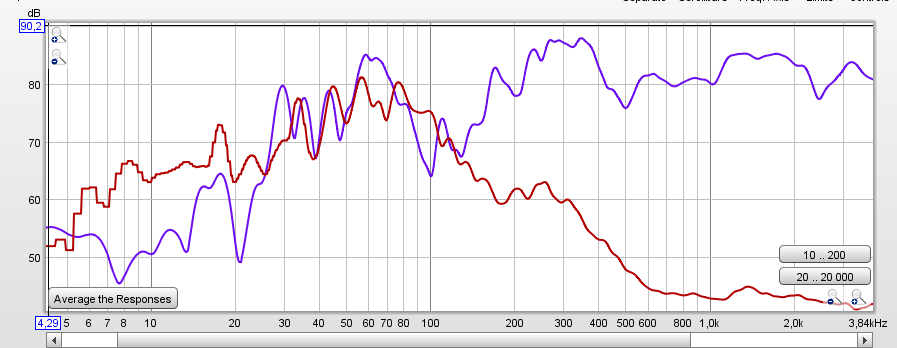
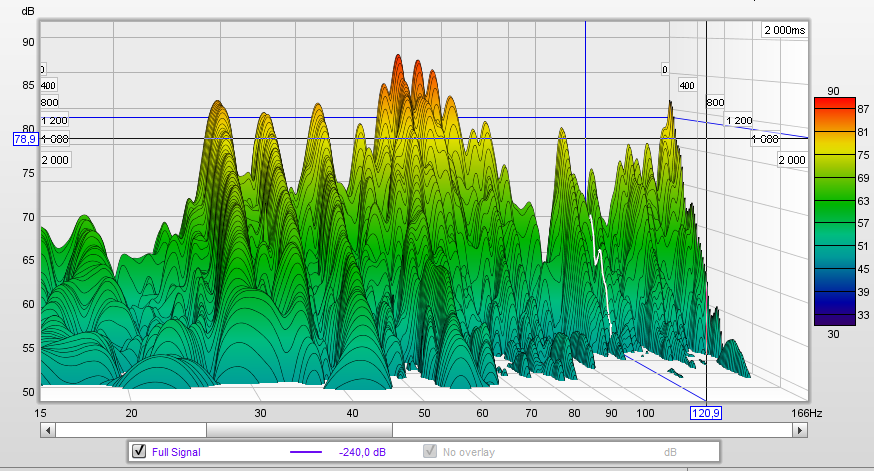


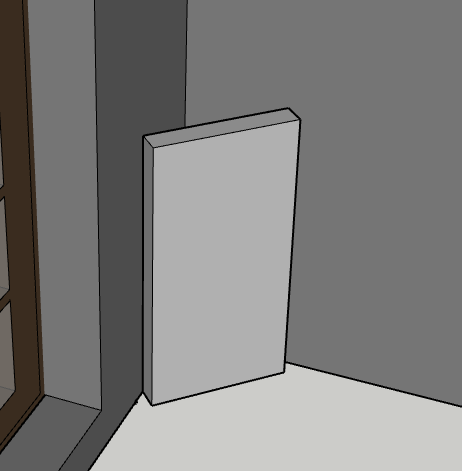
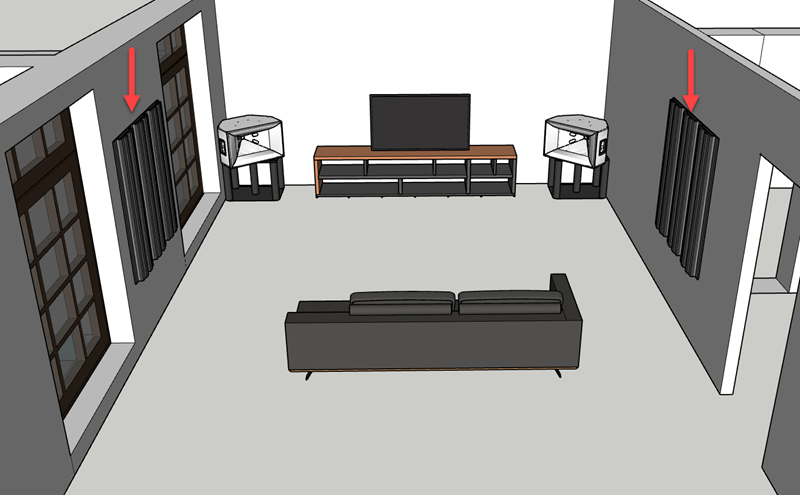







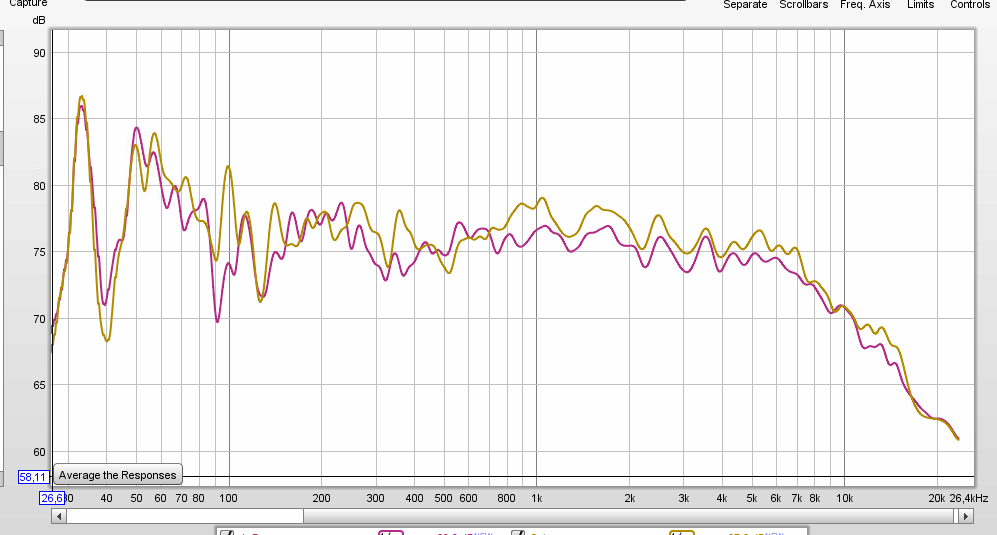








An attempt to build K-402-MEH clone in wood
in 2-Channel Home Audio
Posted
Ok, some measurements at the LP to assess the effect of room treatments:
Reverberation (Topt):
Clarity (C80):
ETC Curve (%FS):
So reverberation time is almost where it should be from about 200hz and onwards and a tab better in the lower frequencies as well.
Clarity has improved indeed: the dialogue is much easier to understand in movies. The amount of detail in music is also much greater.
As for the ETC - this is the first time I am trying to work with this kind of graph. I can see that spikes between 1.5ms and later are seriously reduced. Those between 0 and 1.5ms are not as reduced as the others. But the 'before' measurement also had some treatments near the edge of the horn (1" thick instead of 2" plus a gap that is used now). Is there 'an acceptable level' of ratio between the spike at 0ms and early reflections? Am i near that ideal ratio?
To my ears, the difference is huge. Bass is much easier to comprehend but still a bit boomy. What should i do now? Currently all the traps are placed in the first part of the room. I still have place to add a pair or 200x60cm traps in the second part. Then, a bit later I will buy a huge rack for books and stuff which will also be placed in the end of the room. Will that suffice?